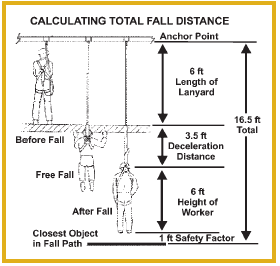| FALL PROTECTION | [BACK] [NEXT] |
|
Making Safety as Easy as 1, 2, 3.. . |
||||
|
|
|
|
||
|
What do I want? Comfort. You want the perfect fit. To ensure aperfect fit, harnesses are available in different sizes. A standard size will fit most workers. See sizing selection chart to determine the best size for you. Ease of Use. You want a harness that is easy foryou to get into and adjust. Harnesses are available in primarily two styles:• Vestype (vest style). A Vestype harness is puton like a jacket. • Pullover (cross-chest). A pullover harness isput on over the head, similar to putting on a sweater. The choice on style is a matter of personal preference. There are also different types of leg strapconnections available on a harness:• Qwik-Fit (mating buckle)• Tongue Buckle
Both styles offer fast and easy connection and adjustment. The choice of leg strap connections is a matter of personal preference.You also have a choice of D-Ring configurationson a harness: Back D-rings (required on every harness), hip (or side) D-rings, or chest D-rings. General D-ring usage is as follows: • Back D-Ring. This is the attachment point foryour lanyard. It can also be used as a rescueattachment. • Hip (or side) D-rings. Typically used forworkpositioning activities to allow the worker to have their hands free to perform work, or for travel restriction applications. • Chest D-ring. Typically used for ladder climbing systems, rescue operations, or personnel riding applications. |
How do I know which to choose? There are two primary types of lanyards: • Shock-absorbing lanyards used when the freefall distance (fall hazard) can exceed 2 feet • Restraint or positioning lanyards used onlywhen free fall distance (fall hazard) can be limited to 2 feet or less In choosing the correct lanyard, you must keepthe application in mind. • Make certain the lanyard is the proper length to allow the necessary worker movement/ positioning. • Make certain that the right material type is chosen (depending on your work environment). – Cable works best in high heat environments or around sharp edges. – Webbing works best in most other applications. • Make certain you have calculated your totalfall distance . See diagram for more information.You also need to consider the compatibility of the system components. Components produced by different manufacturers may not be interchangeable. The best way to ensure compatibility is to purchase all components from the same manufacturer.  |
How do I know which to choose? Connector selection is driven primarily byapplication . You will need to carefully consider your work environment , in particular the type of structure where the connector will be attached. Examples include:• Roof • Scaffold • Steel Beam • Concrete Column • Rail Weight should also be a consideration if aworker will need to carry the connector around during the work day. You will also need to consider the number ofworkers required to attach to the connector.Most connectors are rated for 1 person with a 5,000 pound minimum breaking strength. Connectors are required, by OSHA, to have a minimum breaking strength of 5,000 pounds per person attached. For example, if you are going to attach 2 people to a connector, the connector must be rated to 10,000 pounds.
|
||
|
|
|||
|
Fax: (773) 538-8080 |
Telephone: (800) 275-8239 | Website: www.supersafety.com | page 138 |
|---|---|---|---|